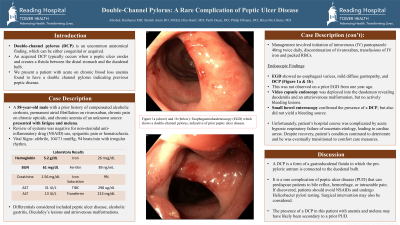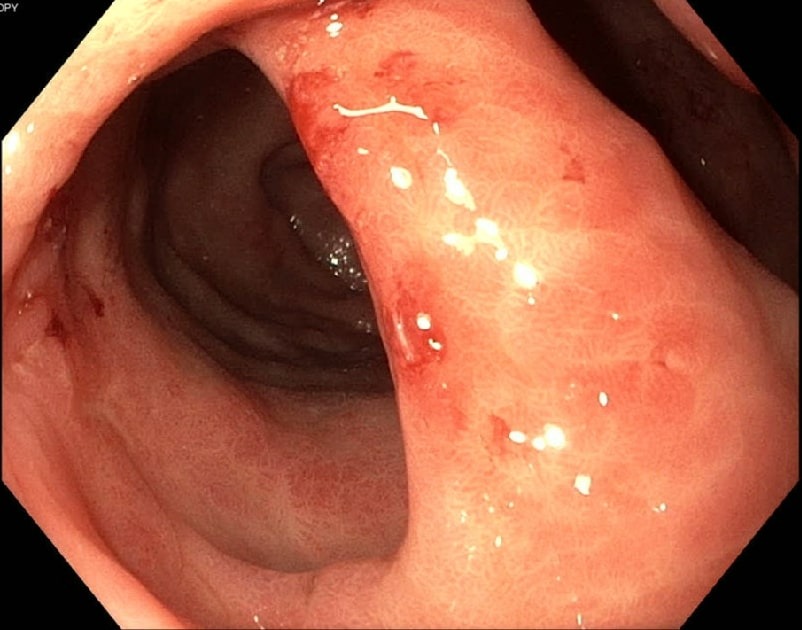Tuesday Poster Session
Category: Stomach
P4205 - Double-Channel Pylorus: A Rare Complication of Peptic Ulcer Disease
Tuesday, October 24, 2023
10:30 AM - 4:00 PM PT
Location: Exhibit Hall

Has Audio

Abishek Hariharan, MD
Reading Tower Health
Reading, PA
Presenting Author(s)
Shefali Amin, DO, MSEd1, Hira Hanif, MD2, Abishek Hariharan, MD3, Parth Desai, DO4, Philip Elbaum, DO3, Brian McAllister, MD3
1Reading Hospital, Reading, PA; 2Reading Hospital Tower Health, Reading, PA; 3Reading Tower Health, Reading, PA; 4Tower Health-Reading Hospital, Reading, PA
Introduction: Double-channel pylorus is an uncommon anatomical finding, which can be either congenital or acquired. Acquired double pylorus typically occurs when a peptic ulcer erodes and creates a fistula between the distal stomach and the duodenal bulb. Risk factors include Helicobacter pylori infection and NSAID medications. We present a case of acute on chronic blood loss anemia found to have a double channel pylorus indicating previous peptic disease.
Case Description/Methods: A 58-year-old man presented to the hospital for fatigue and melena. Past medical history was significant for compensated alcoholic cirrhosis, permanent atrial fibrillation on rivaroxaban, chronic pain on chronic opioids, and chronic anemia with unknown source. He denied NSAID use, epigastric pain or hematochezia. He presented afebrile, 104/71 mmHg, and 94 bpm with irregular rhythm. Admission labs were significant for hemoglobin 5.2g/dL (baseline 7g/dL), hematocrit 17.6%, INR 2.5, low iron studies, blood urea nitrogen 61mg/dL, and normal transaminases. Patient’s anticoagulation was held and he received treatment with blood transfusions and intravenous iron. He then underwent EGD which revealed no esophageal varices, mild diffuse gastropathy, and double channel pylorus (Figure 1) – suspected to be from a prior peptic ulcer. Review of EGD one year prior did not show the double channel pylorus. Video capsule was deployed into the duodenum and returned with duodenitis and an arteriovenous malformation but no actively bleeding lesions. Small bowel enteroscopy confirmed the presence of a double channel pylorus but did not yield a bleeding source. Unfortunately, patient’s hospital course was complicated by acute hypoxic respiratory failure of uncertain etiology leading to cardiac arrest and he was transitioned to comfort care measures.
Discussion: A double channel pylorus is a form of a gastroduodenal fistula in which the pre-pyloric antrum is connected to the duodenal bulb. It is a rare complication of peptic ulcer disease but may predispose patients to bile reflux, hemorrhage, or intractable pain. If found, patients should avoid NSAIDs and undergo H. pylori testing to start treatment as soon as possible. For symptomatic patients, surgical intervention may be considered.

Disclosures:
Shefali Amin, DO, MSEd1, Hira Hanif, MD2, Abishek Hariharan, MD3, Parth Desai, DO4, Philip Elbaum, DO3, Brian McAllister, MD3. P4205 - Double-Channel Pylorus: A Rare Complication of Peptic Ulcer Disease, ACG 2023 Annual Scientific Meeting Abstracts. Vancouver, BC, Canada: American College of Gastroenterology.
1Reading Hospital, Reading, PA; 2Reading Hospital Tower Health, Reading, PA; 3Reading Tower Health, Reading, PA; 4Tower Health-Reading Hospital, Reading, PA
Introduction: Double-channel pylorus is an uncommon anatomical finding, which can be either congenital or acquired. Acquired double pylorus typically occurs when a peptic ulcer erodes and creates a fistula between the distal stomach and the duodenal bulb. Risk factors include Helicobacter pylori infection and NSAID medications. We present a case of acute on chronic blood loss anemia found to have a double channel pylorus indicating previous peptic disease.
Case Description/Methods: A 58-year-old man presented to the hospital for fatigue and melena. Past medical history was significant for compensated alcoholic cirrhosis, permanent atrial fibrillation on rivaroxaban, chronic pain on chronic opioids, and chronic anemia with unknown source. He denied NSAID use, epigastric pain or hematochezia. He presented afebrile, 104/71 mmHg, and 94 bpm with irregular rhythm. Admission labs were significant for hemoglobin 5.2g/dL (baseline 7g/dL), hematocrit 17.6%, INR 2.5, low iron studies, blood urea nitrogen 61mg/dL, and normal transaminases. Patient’s anticoagulation was held and he received treatment with blood transfusions and intravenous iron. He then underwent EGD which revealed no esophageal varices, mild diffuse gastropathy, and double channel pylorus (Figure 1) – suspected to be from a prior peptic ulcer. Review of EGD one year prior did not show the double channel pylorus. Video capsule was deployed into the duodenum and returned with duodenitis and an arteriovenous malformation but no actively bleeding lesions. Small bowel enteroscopy confirmed the presence of a double channel pylorus but did not yield a bleeding source. Unfortunately, patient’s hospital course was complicated by acute hypoxic respiratory failure of uncertain etiology leading to cardiac arrest and he was transitioned to comfort care measures.
Discussion: A double channel pylorus is a form of a gastroduodenal fistula in which the pre-pyloric antrum is connected to the duodenal bulb. It is a rare complication of peptic ulcer disease but may predispose patients to bile reflux, hemorrhage, or intractable pain. If found, patients should avoid NSAIDs and undergo H. pylori testing to start treatment as soon as possible. For symptomatic patients, surgical intervention may be considered.

Figure: Figure 1: Double-channel pylorus found on EGD suspicious for a previous peptic ulcer.
Disclosures:
Shefali Amin indicated no relevant financial relationships.
Hira Hanif indicated no relevant financial relationships.
Abishek Hariharan indicated no relevant financial relationships.
Parth Desai indicated no relevant financial relationships.
Philip Elbaum indicated no relevant financial relationships.
Brian McAllister indicated no relevant financial relationships.
Shefali Amin, DO, MSEd1, Hira Hanif, MD2, Abishek Hariharan, MD3, Parth Desai, DO4, Philip Elbaum, DO3, Brian McAllister, MD3. P4205 - Double-Channel Pylorus: A Rare Complication of Peptic Ulcer Disease, ACG 2023 Annual Scientific Meeting Abstracts. Vancouver, BC, Canada: American College of Gastroenterology.
